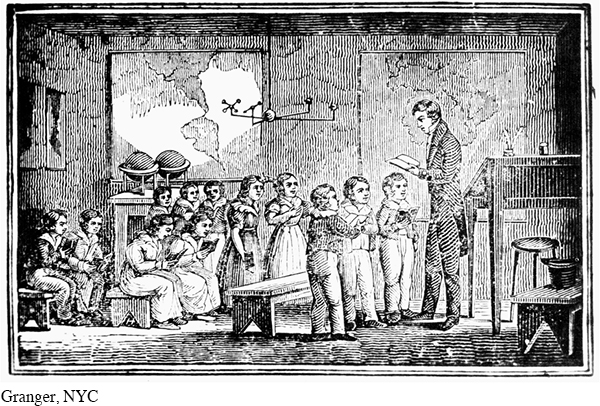Education for a New Nation
The desire to create a specifically American culture began as soon as the Revolution ended. In 1783 Noah Webster, a schoolmaster, declared that “America must be as independent in literature as in Politics, as famous for arts as for arms.” To promote his vision, Webster published the American Spelling Book (1810) and the American Dictionary of the English Language (1828). Webster’s books were widely used in the nation’s expanding network of schools and academies and led to more standardized spelling and pronunciation of commonly used words.
Before the Revolution, public education for children was widely available in New England and the Middle Atlantic region. In the South, only those who could afford private schooling—perhaps 25 percent of the boys and 10 percent of the girls—received any formal instruction. Few young people enrolled in high school in any part of the colonies. Following the Revolution, state and national leaders proposed ambitious plans for public education, and in 1789 Massachusetts became the first state to demand that each town provide free schools for local children, though attendance policies were decided by the towns.

The American colonies boasted nine colleges that provided higher education for young men, including Harvard, Yale, King’s College (Columbia), Queen’s College (Rutgers), and the College of William and Mary. After independence, many Americans worried that these institutions were tainted by British and aristocratic influences. New colleges based on republican ideals needed to be founded.
Frontier towns offered opportunities for colleges to enrich the community and benefit the nation. The relative isolation of these villages ensured that students would focus on education. And frontier colleges provided opportunities for ethnic and religious groups outside the Anglo-American mainstream—like Scots-Irish Presbyterians—to cement their place in American society. The young nation benefited as well, albeit at the expense of Indians and their lands. For example, the founding of Franklin College in Athens, Georgia, encouraged white settlement in the state’s interior, an area still largely populated by the Creek and Cherokee.
Frontier colleges were organized as community institutions composed of extended families, where administrators, faculty, and their wives guided students, hosted social events, and hired local workers, including servants and slaves. Women were viewed as exemplars of virtue in the new nation, and professors’ wives served as maternal figures for young adults away from home. Families of modest means could send their sons to these less expensive colleges, depending on faculty couples to expand their intellect and provide moral guidance. In some towns, students at local female academies joined college men at chaperoned events to cultivate proper relations between the sexes.
Exploring American HistoriesPrinted Page 244
Exploring American Histories Value EditionPrinted Page 181
Chapter Timeline